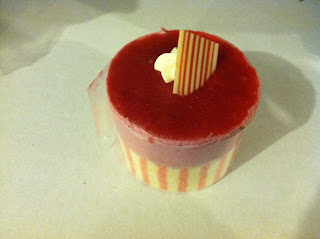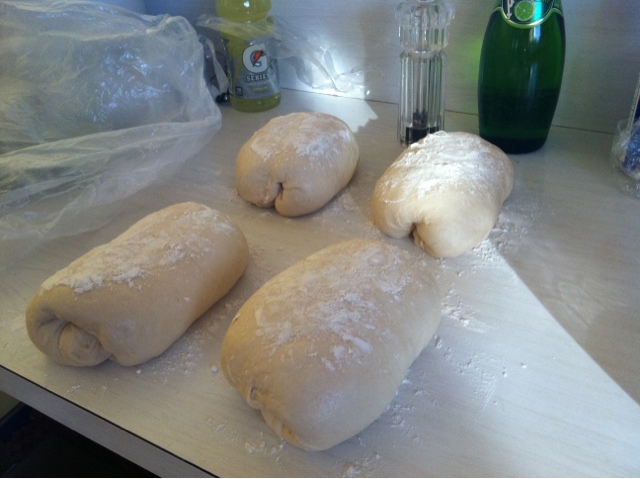
This is a consistent favorite among those I bake for on a regular basis. It's a bread with a seemingly infinite amount of character, while not being terribly complex for the novice baker wishing to enhance their "out of the box" repertoire.
There are two ways one can approach focaccia. The easier, less flavorful option would be to mix, proof (rise), and bake all on the same day. This can certainly yield an acceptable and flavorful loaf depending on the amount of herbs and seasonings used, but once tasting the second option, you'd know something was missing. It's for this reason, I'll only go into detail about the option which is best in my opinion and that is to mix a pre-ferment called a sponge or "Poolish" the evening before mixing the dough, coupled with using a sourdough starter to not only lend a great flavor, but contribute to an assured, even rise. Ok, let's get started!
Equipment:
Kitchen scale (available at any local kitchen wares store)
Medium sized plastic container with lid
One industrial half-size sheet pan (jelly roll pan)
Your fingers (hope you have all of 'em)
Electric stand mixer (or Bosch)
Large bowl
Ingredients:
Sponge:
-8oz of the highest quality plain white or bread flour you can find. I use a special freshly milled flour from my local mill which isn't available to everyone, but I strongly suggest either King Arthur's Bread or All Purpose flour for the regular home baker.
-6oz warm water (filtered is best but tap will do)
-1/16 tsp Instant Active Dry Yeast. SAF is the best and most consistent brand in the industry, but if you're unable to get it, Fleischmanns from the supermarket has certainly worked well for me in the past.
Final dough (needed for next day):
-20oz same flour
-16oz warm (NOT HOT) water
-3T sourdough starter (if desired and available keeping in mind that omitting will still yield great flavor and rise, but slightly lessened than if using. I can tell the difference, but you may not care)
-.4oz instant active dry yeast
-1oz olive oil
-.5oz salt
-14 oz of sponge from day 1
-Fresh herbs and seasonings on top of final dough (to taste). I usually use 5-7 sprigs of fresh rosemary freshly chopped, as well as organic sea salt.
Procedure for mixing sponge:
- Mix all ingredients together in plastic container, ensuring all of the flour is properly hydrated. The water cannot be too hot or the yeast will die, but I've found warm water to be the most effective in yielding a highly active fermentation overnight.
- Place lid on tightly and ferment at room temperature (at least 75 degrees, but the warmer the better) at LEAST 15 hours.
Procedure for final dough:
- Remove the sponge (which should look HIGHLY active at this point) from the container and chop into pieces.
- Place the warm water into mixing bowl followed by approximately half of the sponge then sprinkle yeast on top of the warm water evenly.
- Add remaining ingredients except topping (herbs and sea salt if using).
- Mix on speed two for kitchenaid mixers (I have 600 Professional) or whatever speed your manufacturer recommends for developing gluten in bread doughs as every one differs for 6 minutes.
- Remove cohesive dough from the mixing bowl, and place in lightly greased large bowl.
- Cover with plastic and let ferment at room temperature about 35 minutes or so. The time isn't terribly important as long as it's at least 20 minutes. The longer you leave it, the more flavor and fullness it'll have.
- About half way through fermenting, give the dough a turn. To do this, reach under the dough and grab a chunk from the bottom. Stretch it over the top and press it down. Repeat this process at least 4 times or so or until you think all of the dough has been circulated and rotated. This allows the gluten to continue to strengthen and will lend a great strength to the finished product as this dough is by nature fairly loose or sticky.
- After fermentation is complete, pour 6 oz of olive oil into your 1/2 sheet pan, then place the dough on the pan ensuring to flip it to coat both sides. Cover the pan and dough mass with some plastic and allow to relax and ferment for another 30 minutes. If you try to press it out into the corners before resting it, it'll continue to come together as the gluten strands are too strong. Relaxing the dough allows us to shape and form the dough as we see fit.
- After the last 30 minutes, press and stretch the dough out into the corners, ensuring an even thickness of dough throughout, then coat entire top layer with olive oil. Don't worry about the amount of olive oil you use. It'll seem like you're using way too much but I assure you that you aren't and that the loaf will absorb whatever you put on top.
- Sprinkle your favorite seasoning, herbs, or topping on top and allow to rise for another 20 or 30 minutes. Is you used the starter, the rise would only need to be maybe 10 or 15 minutes. Then dimple using your fingers (told you you'd need them). Below is the starter loaf after rising (hugely active with gaseous bubbles, and following is the simple straight yeasted loaf with no starter which I hadn't fully stretched into the corners just yet but you can still see the volume difference at this point using a starter. I think you'll be surprised by just how much they rise in the oven, so don't be worried is it didn't double in the pan because you'll get your volume.


- After the dough has risen a bit in the pan (no specific amount), bake at 375 degrees approx 18 or 20 minutes or until a beautiful even golden brown and the loaf sounds somewhat hollow when tapped. Remove from pan and cool on rack. This is what the sourdough loaf came out looking like, and the regular follows.


Both loaves have come out beautifully, and we ate BOTH for dinner that night which was Thanksgiving incidentally. Focaccia when sliced horizontally makes EXCELLENT sandwich bread and when sliced into strips is perfect for dipping in balsamic or the dip of your choice!
Hope this was informative and easy enough to understand. If not, let me know and I'll definitely change my approach. For the next time for sure though I'll remember to post pictures of the entire process.
ENJOY!






































